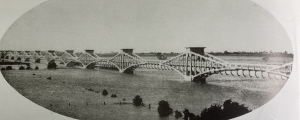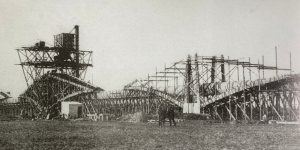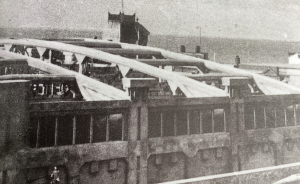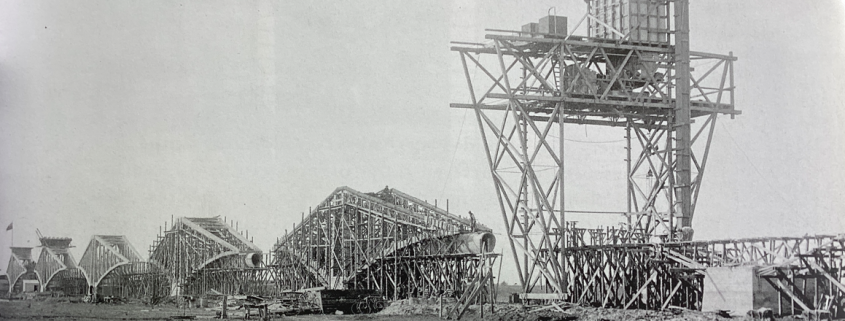Philistines at the gate

It’s tough seeing Australia’s rich legacy of built heritage so often vanish before your eyes.
And tough watching important buildings slowly fall into disrepair, succumbing to the old ploy of demolition by neglect.
No fun seeing them surreptitiously knocked over in the night by owner-vandals or set alight by arsonists in friction-fire attacks where insurance policies rub up against mortgage papers.
Crook, too, when they’re disappeared by home renovators flying under the radar of planning laws.
Gets nasty and personal when you see the historic house where you and all your schoolmates were born demolished and replaced by a McDonald’s outlet. And worse when old mates who numbered the bricks to rebuild it haven’t done so decades later.


The aqueduct under construction, and the Bow Truss woolstore.
Not unlike the Marshall bluestone cottage demolished for Barwon Heads Road works where locals were assured it would be rebuilt elsewhere. Two levels of government presently shirking any responsibility.
It’s especially tough, however, when demolition of this built fabric of the community is legally sanctioned by authorities.
Nothing short of barbarianism how so many stunning buildings that made Melbourne the greatest city in the world during the gold boom of the 1800s failed to last even 60 or 70 years before they started being ripped down.
By the time of the Melbourne Olympics, most were considered a shameful, ageing disgrace that needed culling in a modern international city under the world’s gaze – never mind that cities in war-torn Europe were rebuilding their shattered architectural treasures.
All culled in the name progress, that weasel-word justifying the Philistine finance-driven destruction of the design, culture, social milieu and beauty within the built form that created our cities. Cradles burnt on the altar of Mammon.
Schools, pubs, churches, grand shops, public institutions, woolstores, any number of homes making up a living museum of Australian architecture have been fuel to the fires of progressive expediency.
Geelong’s been as much as shocker as anyone for bowling over anything with any semblance of legacy, history, heritage, social or cultural connection.
There might still a good bit about and, yeah, some praiseworthy efforts at restoration and preservation. But I’ve seen some sad losses in Geelong and I watching with trepidation every time I see a planning notice on the front fence of any old house in Geelong.
The Dell and The Priory mysteriously disappeared when the adjoining Ariston House was earmarked as a childcare centre. North Geelong Primary, learning centre of so any post-war migrants, almost disappeared to arson. Deakin Uni’s social housing museum of historic regional buildings was put to bed by none other than the uni that oversaw its creation.
Waverley House was knocked down to make way for the waterfront’s Crowne Plaza complex, with gormless CFMEU vandals hosing National Trust protesters for their temerity. Jack Mundey should have been cartwheeling in his grave.
Two lovely between-the-war homes next to The Palais gave up the ghost without a whisper. Now a heritage car park. An ancient forgotten chapel behind the old Aberdeen Chateau near my place was smartly demolished in front of me one Saturday morning without ceremony or recognition.
The CBD has long hosted vacant buildings left to rot in their footings. Buildings that can’t be knocked down but which also can’t be rebuilt, or renovated so they might be repurposed. I’ve also seen owners refuse to repair their properties.
I kind of like the idea of owners who deliberately destroy heritage buildings being forced surrender the land’s title. But I’ll admit it’s a bit heavy, there’s no doubt maintenance costs are real and not everyone can afford them. And that you’re unlikely to be able to readily sell such a property, making compulsory acquisition maybe not such a bad idea.
I do spy an irony in the architectural landmark that is the Geelong Heritage Centre, contrasting the fact so much of Geelong’s architectural heritage has vanished.
Similarly, in comparisons drawn between the heritage Dennys Lascelles Bow Truss Building on the site of the present-day TAC HQ and the heritage Breakwater aqueduct Barwon Water wants to bring down.
The former was demolished by the State Government in its own heritage advice, not to mention World Heritage condemnation. Now a government water utility wants to do the same to the aqueduct, renowned for its magnificent bowstring design akin to Scotland’s famed Firth of Forth bridge.
The move is driven by concerns about its deteriorating concrete collapsing and presumably some attendant legal liability, even if ducks are probably the only denizens of the underlying swampland likely to be injured in any such instance.
I can’t help but wonder if demolition crews might not encounter the same significant difficulties they did when trying to wreck the Bow Truss building. And yet it was purportedly in danger of imminent collapse.
Just like the aqueduct was 30 years ago, when a report for Barwon Water said the structure could collapse at any time. Funny, it’s still there. Fancy that, the ducks must be getting nervous.


